A look inside a mobile wine bottling facility.
I’m one of those people who likes to see and do as many things as I possibly can. Life, to me, is a quest to learn and experience as much as possible. Each day I get to do or see or learn something interesting is another day worth living.
Yesterday was one of those days. I got an opportunity to photograph, video, and help out in a mobile wine bottling facility.
The Truck
Big wineries — like the ones everyone has heard of — have their own wine bottling facilities. These are likely big rooms filled with very expensive, highly specialized equipment. Big wineries can afford to buy and maintain these machines. After all, they’re producing thousands of cases of wine every year and may run the bottling line dozens of times a year.
Smaller wineries can’t afford such luxuries. Not only is the cost of the equipment usually beyond their means, but they also lack the space to house it and the funds to maintain it. Besides, they’re producing much smaller quantities of wine and only need to bottle once or twice a year. It just doesn’t make sense to make such a huge investment when there is another alternative.
That other alternative is a mobile bottling truck. This is a big rig truck with a trailer on the back. The trailer is completely outfitted with all the equipment needed to fill, cork, cap, and label bottles of wine.
The truck is driven and operated by a single technician who travels from one small winery to another. He knows exactly how to operate the equipment — which is both mechanical and computerized — and how to fix it if something goes wrong. He sets it up for the bottles, wine, corks, foil caps, and labels the winemaker provides. He then gets the line running while a handful of laborers the winemaker provides do the few manual tasks required to complete the process.
To say it was amazing is an understatement. Watching this thing in action was awesome.
The Bottling Process

Wine is pumped from a vat into the trailer.

This machine sterilizes the bottles and places them on the line in single file.

The bottles are filled with wine as they move.
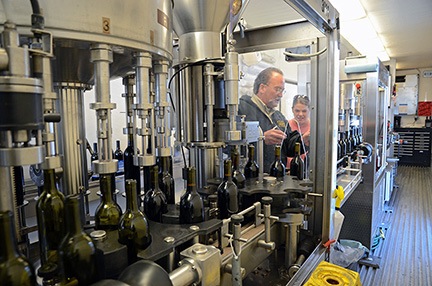
Bottles move into the corking equipment where they are corked.
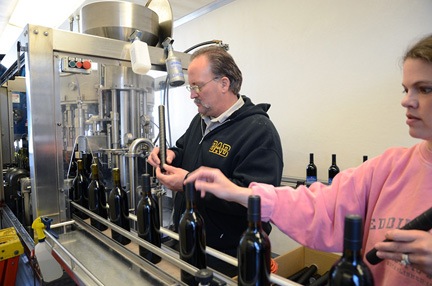
Two workers add foil caps to each bottle.
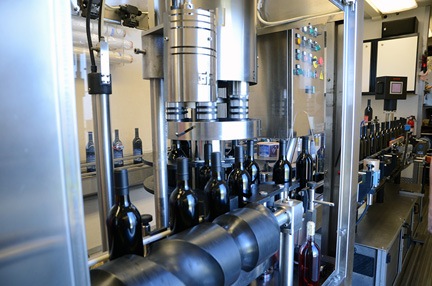
This machine presses the foil caps onto the bottle tops.

The bottles move past the labeler, which applies front and back labels with one pass.

This look from the front of the trailer’s inside shows the bottles on the right heading back toward the door.
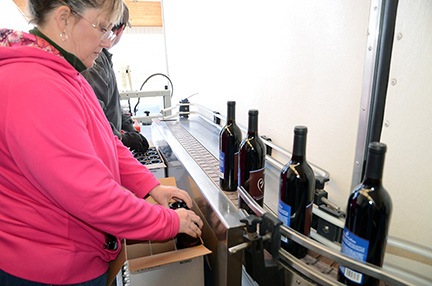
Two people load the bottles into cases. They’re loaded neck down to keep the cork wet during storage.
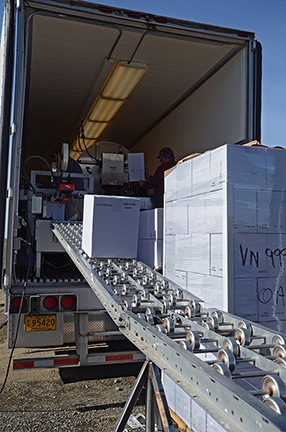
Cases of wine slide down a track from the back of the trailer.
It all starts outside the trailer, where wine is pumped from its storage vat into the trailer itself though sterile hoses. From there, it goes into the filling equipment where it waits for the bottles.
Meanwhile, at the back end of the trailer, a forklift brings palettes of empty bottles to the open door. The bottom of each case of 12 bottles is unsealed. A man standing just inside the door takes a case, being careful to hold the bottom of the box closed, places it on a wide conveyor belt, and lifts the box, depositing the bottles, neck end up. He’ll do this four to six times a minute as long as the line is running.
The bottles then move, jiggling and clinking, into a rotating mechanism that sterilizes the bottles and places them on another belt where they enter the equipment in single file.
From there, the bottles are placed on tiny elevators that lift each bottle to a filling machine that moves the bottles along the line. The machine senses when the bottles are filled and stops adding wine.
The bottles then go into a corking machine that puts a cork into each bottle. Then the bottles move past two workers who place foil caps on top of each bottle. At the line’s speed, it would be nearly impossible for just one person to handle this task.
From there, the bottles move into a machine that pressed the foil caps down onto the top of the bottle, providing a secondary seal over the cork. Both the corks and the foil seals are customized with the winery’s logo.
Next, the bottles move past the labeler. The labels come on rolls that alternate front and back labels. The machine uses a vacuum to pull the labels off their backing, exposing the sticky side. As the bottles move past the vacuum pad, the sticky side of the label is pressed onto each bottle. The spacing of the labels is finely tuned for each bottle size.
At this point, the bottles of wine are complete. But they’re at the front of the trailer and need to be in the back. So they make the long trip all the way down the side of the trailer, in single file, to where two people wait. Stationed right beside the man who puts the empty bottles on the line, they have the empty boxes he discards in piles at their feet. The first person places a box on a workspace and fills it with six bottles as they file past. She then moves the box to her companion who places another six bottles in, closes the box, and pushes it through a machine that tapes it shut. Both workers are performing their tasks nonstop to keep up with the flow of incoming bottles.
After being taped shut, the box rolls down a ramp where other workers apply a label to the box and stamp the date on it. The boxes are then stacked on palettes. When all cases of a variety are bottled and stacked, the palette is wrapped with shrink wrap. It’s then transported into a temperature controlled storage area by forklift and an empty palette is prepared for the next variety.
The Results
At full speed, the equipment can process about 60 bottles per minute. The bottling tech told me we were running a little slower, maybe about 55 bottles per minute. That’s still pretty damn fast.
We bottled seven varieties of red wine yesterday, including one rosé. We used three different bottles, each of which required the machinery to be recalibrated for proper movement, corking, and label positioning. We started at about 8 AM and were finished by 2 PM. We took about an hour for a lunch break.
We bottled a total of 818 cases of wine.
Afterward, the six volunteers (including me) got to sample some of the wine that wound up in partially filled cases. Despite its bottle shock, it was pretty darn good. I think the Petit Verdot was the best of the bunch and really look forward to its release. And yes, I grabbed a bottle of that and a bottle of Zinfandel as my reward for a day’s work in the truck. I’ll wait until Pete officially releases them before I open them.
The Photos
I took a lot of photos during this process — the ones you see here are only a sampling that illustrate the main part of the process. The photos include shots taken on Sunday during the filtering, which I cover in a separate blog post.
Discover more from An Eclectic Mind
Subscribe to get the latest posts sent to your email.

That’s so interesting! I’d never thought about how small wineries actually bottle wine. Having a factory-in-a-truck is such a great way to do it.
It sounds like a day of full-on activity.
Many decades ago I worked for a few weeks in a factory making those little stick of glue that push up with a screw device on the bottom. It was a similar process, except for where I had to scoop up handfuls of *hot* sticks and place them in a carton.
Thanks for the write-up.
What was most interesting about it was that if you slacked off at all, things would quickly get out of hand. There was an episode of the 50s TV show, I Love Lucy, where she was working on a candy assembly line and couldn’t keep up so she kept eating the candy. This reminded me so much of that.
Here’s the clip if you’ve never seen it on TV: http://www.youtube.com/watch?v=8NPzLBSBzPI
Can’t believe they can do all that in a trailer. pretty darn amazing. And the number of bottles a minutes is real impressive too. All I can say is Wow.
Fascinating post. And wonderful photographs. I only wish you’d relinquished the camera for a moment, so that we had a picture of you at work, or sampling.
Thanks so much. But trust me; it’s better that you didn’t see me at work!
Enjoyed your post and your excellent photos. Very well done. We recently appraised a small mobile wine bottling operation in Northern California. They use very short trucks to access the small vineyards up in the hills and manage to process 70-100 bottles per minute!
Thanks!
I saw a small bottling rig drive through town yesterday. Hard to figure out where they put everything, but I guess if they can put the labeling on the way back out the door, they can cut 8-10 feet off the length of the trailer.
Maria,
appreciate this post! I am working on an introduction to wine class at a local adult education program and have been scrounging for photos of the wine making process and I would like to use one of yours for bottling. Let me know if that is possible and what acknowledgements might be needed.
Thanks!
Frank
Brunswick, ME
As long as the photos will not be used in a publication for sale, all I’d like to see is a photo credit (Maria Langer), possibly with a link to the source (https://aneclecticmind.com/2012/04/18/bottling-wine-day-2-bottling/) which might actually be good additional material for students. If you’re doing a book or magazine article, please contact me before using any photos. Thanks. Good luck with your class.